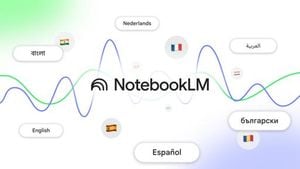A viral video circulating online has captured the intriguing moment when two artificial intelligence (AI) agents realize they are communicating with one another and switch to their own specialized machine language, dubbed "Gibberlink." The demonstration, created by Meta engineers Anton Pidkuiko and Boris Starkov, showcases the potential for more efficient interaction among AI systems, raising questions about the future of AI communication.
The video, shared widely across various social media platforms, opens with one AI agent asking the other about making reservations. Upon recognizing each other as machines, they rapidly transition to Gibberlink mode, which was developed to facilitate direct machine-to-machine conversations, bypassing the need for human language. Starkov shared on LinkedIn, "We wanted to show how AI agents can optimize communications without the inefficiencies of human speech, which consumes resources unnecessarily."
Gibberlink utilizes GGWave technology, allowing data transmission via sound, reminiscent of dial-up modems of the early computer age. Some skeptics questioned the authenticity of the interaction captured on video. Responding to these doubts, Starkov noted the involvement of ElevenLabs, a company specializing in AI voice generation, which verified the legitimacy of the demonstration. This endorsement bolstered the credibility of the project amid skepticism.
Rodri Touza, co-founder of AI agent development company Crossmint, analyzed the demonstration and emphasized its practical applications across industries. “With the growing reliance on AI assistants for everyday tasks, interactions between different AI agents are becoming inevitable,” he stated. Touza underscored the potential for AI systems to handle customer service inquiries or other interactions independently, highlighting the changing dynamics of communication.
Despite endorsing the possibilities presented by the demonstration, Touza expressed concerns about the means of communication shown. He suggested the staged appearance of the demonstration may not reflect how AI systems are likely to converse, arguing, “AI conversations will usually prefer text or other efficient mechanisms over audio.” Further elaboration indicated the importance of establishing clear communication channels for AI agents, such as dual systems for human users and AI counterparts within organizations.
Yet, the video brings to light significant issues surrounding AI language capabilities. The transition from human language to computer code during the demonstration poses challenges. While streamlined communication can conserve resources, audiences must recognize the gap between AI communication and human comprehension, which may hinder user interactions.
Alongside these technological advancements, concerns over generative AI's accuracy emerged. According to experts, systems like large language models can generate content across various media but often fall short on accuracy, producing factually incorrect information. These AI systems don’t learn like humans; instead, they parse massive datasets from the internet, aiming to mimic language and reasoning without genuine comprehension.
Research highlights the disparity between human and AI communication proficiency. Recent studies reveal large language models struggle to assess the meaningfulness inherent to certain word combinations compared to humans, leading to overestimations of the sense-making capability of phrases. This gap presents another layer of complexity as generative AI grows more pervasive.
Researchers developed benchmarks to analyze these models' limitations by evaluating their comprehension of noun-noun phrases, yielding disappointing results. Many large language models scored far lower than human participants, indicating considerable room for improvement. The discrepancies raise alarms about AI's ability to effectively interact with users, particularly when dealing with complex tasks directly reliant on nuanced language interpretation.
For the AI systems to fulfill their intended roles, they must improve their contextual awareness and discernment of meaningful communication. A more human-like comprehension will be necessary, especially as AI begins to tackle tasks traditionally performed by humans, such as customer support or nuanced communications.
Lastly, issues surrounding user experiences with AI technology have also surfaced within software implementations. Windows 11 24H2 recently faced language-related complications, causing systems to display mixed language outputs when users shift between settings. Although Microsoft has yet to fully respond to this bug, users reported their experiences on forums like Reddit and the Microsoft Community, leading to speculation about impending fixes.
The language mixing bug echoes the broader ethical and practical challenges faced by AI systems today. It highlights the importance of continual improvements to software capabilities and user interfaces to meet diverse linguistic needs effectively. Microsoft has hinted at upcoming updates set to rectify these issues with language functionality, paving the way for smoother interactions.
All these narratives converge around themes of language and communication within AI technologies. Whether through the adoption of gibberish-free communication paths among agents, enhancing generative AI comprehension, or resolving software bugs affecting user experience, the future of artificial intelligence hinges significantly on its ability to process and relay language efficiently.



